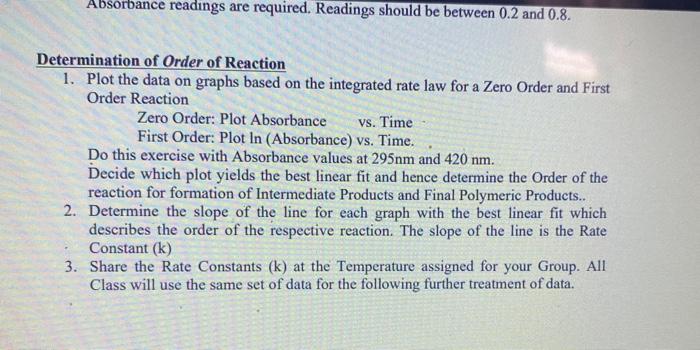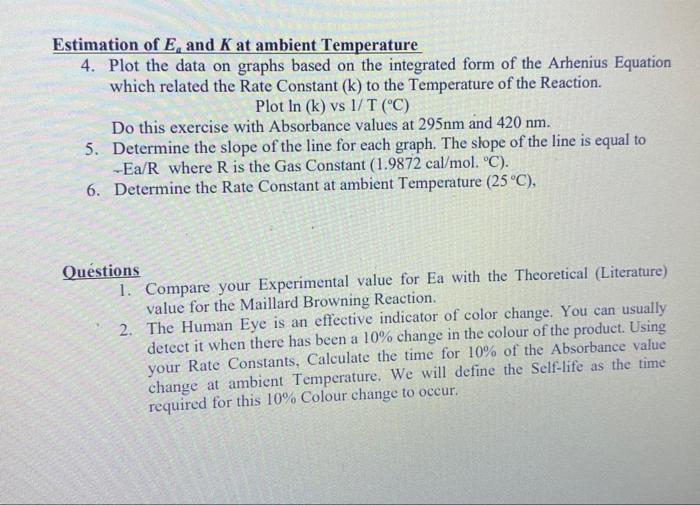for the lab below, answer questions 1&2 and also add Discussion and conclusion
LAB\#3B: KINETICS OF MAILLARD BROWNING REACTION The aim of this Lab Exercise is to investigate the effect of Temperature on the Maillard Browning reaction between the aldohexose sugar,Glucose and the amino acid, Glycine. Procedure: Browning Reaction 1. Each Group will be assigned one (1) of five (5) Temperatures (30C,55C,65C, 75C,90C ) and the Class will share the data for Kinetics study. 2. Mix 25ml of 10% Glucose Solution in each of two (2) Test Tubes and add 25ml 10% Lysine Solution to each Test Tube. Mix the contents and Cover the Test Tube with Aluminium Foil and place it at the assigned Temperature on the Lab Bench (30C), in a WaterBath (55C,65C,75C) and in an Oven (90C). Duplicate your treatment. Remove a 5ml aliquot at Time=0 mins and place it in an Ice Bath. 3. Remove further 5ml aliquots from each Test tube at appropriate time intervals and place in an Ice Bath. Time of sampling is expected to be different for each Group. 4. Read the Absorbance of these solutions at 295nm and 420nm. At least five (5) Absorbance readings are required. Readings should be between 0.2 and 0.8. Determination of Order of Reaction 1. Plot the data on graphs based on the integrated rate law for a Zero Order and First Determination of Order of Reaction 1. Plot the data on graphs based on the integrated rate law for a Zero Order and First Order Reaction Zero Order: Plot Absorbance vs. Time First Order: Plot ln (Absorbance) vs. Time. Do this exercise with Absorbance values at 295nm and 420nm. Decide which plot yields the best linear fit and hence determine the Order of the reaction for formation of Intermediate Products and Final Polymeric Products.. 2. Determine the slope of the line for each graph with the best linear fit which describes the order of the respective reaction. The slope of the line is the Rate Constant (k) 3. Share the Rate Constants (k) at the Temperature assigned for your Group. All Class will use the same set of data for the following further treatment of data. Estimation of Ea and K at ambient Temperature 4. Plot the data on graphs based on the integrated form of the Arhenius Equation which related the Rate Constant (k) to the Temperature of the Reaction. Plot ln (k) vs 1/T(C) Do this exercise with Absorbance values at 295nm and 420nm. 5. Determine the slope of the line for each graph. The slope of the line is equal to Ea/R where R is the Gas Constant (1.9872cal/mol.C). 6. Determine the Rate Constant at ambient Temperature (25C), Qustions 1. Compare your Experimental value for Ea with the Theoretical (Literature) value for the Maillard Browning Reaction. 2. The Human Eye is an effective indicator of color change. You can usually detect it when there has been a 10% change in the colour of the product. Using your Rate Constants, Calculate the time for 10% of the Absorbance value change at ambient Temperature. We will define the Self-life as the time required for this 10% Colour change to occur









